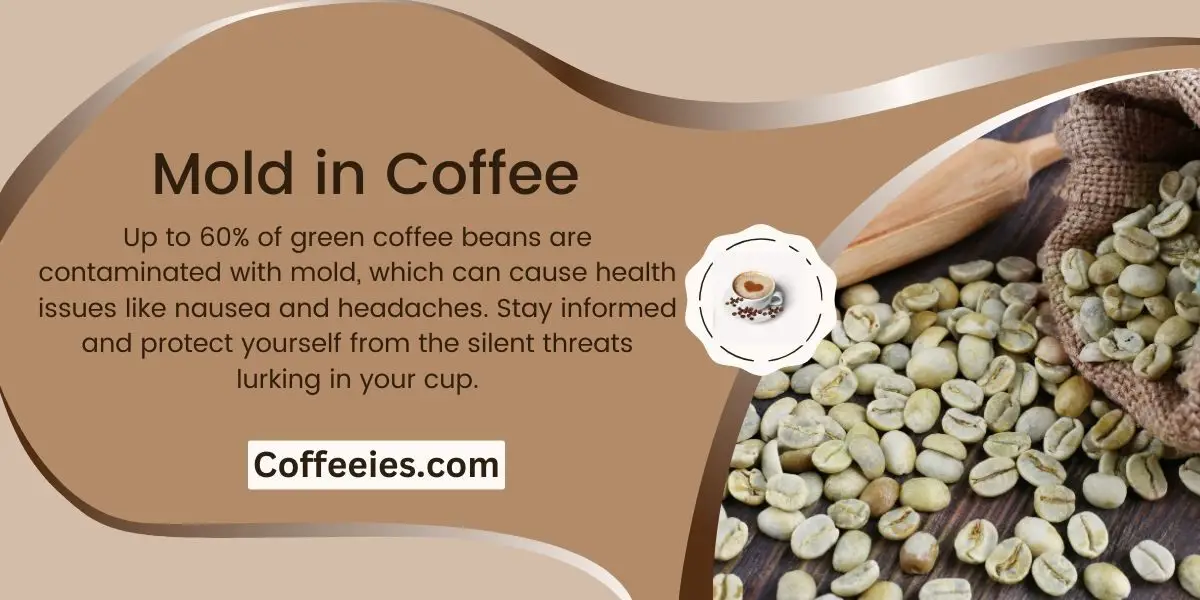Have you ever wondered if your morning cup of coffee could harbor a hidden threat: Mold in Coffee?
Did you know that up to 60% of green coffee beans are mold-contaminated? This mold can produce toxins called mycotoxins, potentially making you sick.
Find out how to avoid these risks, ensuring your daily brew is safe to drink. Stay informed and protect yourself from the silent threats lurking in your cup.
Summary
- Up to 60% of green coffee beans are contaminated with mold, which can cause health issues like nausea and headaches.
- Mycotoxins in coffee are invisible, tasteless, and odorless, posing a silent threat to health.
- Consuming moldy coffee can lead to respiratory issues, digestive problems, and neurological effects.
- To safeguard against mold and mycotoxins in coffee, opt for high-quality beans, proper storage, and regular inspection for signs of contamination.

The Hidden Dangers in Your Morning Brew
You should be aware of the hidden dangers lurking in your morning brew. While savoring that steamy cup of joe, you might not realize that your beloved coffee could harbor harmful mold and mycotoxins.
These microscopic fungi can grow on coffee beans during the production process, especially in humid climates or improper storage conditions.
When consumed, mold and mycotoxins can potentially cause health issues such as nausea, headaches, and even more severe reactions in some individuals.
To ensure your coffee is safe to drink, it’s crucial to be mindful of these hidden risks and take necessary precautions.
Understanding the presence of mold contamination in coffee is essential for safeguarding your health and enjoying your favorite morning beverage without worry.

Understanding Mold Contamination in Coffee
When inspecting coffee beans, look for any visible signs of mold contamination. It’s crucial to ensure that your coffee is free from mold that could harm your health.
Here are some key indicators to help you identify mold contamination in your coffee:
- Visual Inspection:
- Check for fuzzy or powdery white, green, or black spots on the beans.
- Smell Test:
- Sniff the beans for any musty or off odors, which could indicate mold presence.
- Texture Examination:
- Feel the beans for any slimy or sticky residue, a common sign of mold growth.
Mycotoxins: The Silent Threat in Your Cup
Avoiding mycotoxins in your coffee is essential for your health and well-being.
To minimize your exposure to mycotoxins, opt for high-quality coffee beans from reputable sources, ensure proper storage in a cool, dry place, and consider choosing coffee brands that test for mycotoxin levels.
Being vigilant about mycotoxins allows you to enjoy your daily coffee without compromising your well-being.

Health Risks Associated With Moldy Coffee
Drinking moldy coffee can pose serious health risks, so it’s important to be aware of the potential dangers of consuming contaminated beans.
When you unknowingly sip on mold-infested coffee, you are subjecting your body to various health hazards:
- Respiratory Issues:
- Inhaling mold spores from coffee can trigger allergies and worsen asthma symptoms.
- Digestive Problems:
- Consuming mycotoxins in moldy coffee may lead to stomach discomfort, nausea, and vomiting.
- Neurological Effects:
- Mycotoxins present in moldy coffee can impact brain function, causing headaches and dizziness.
Stay vigilant about the quality of your coffee beans to safeguard your well-being and enjoy your favorite brew without risking your health.
Tips for Safeguarding Your Daily Coffee Fix
Elevate your coffee experience and prioritize your well-being with these simple yet essential practices. By following these expert tips, you can enjoy your daily coffee fix with peace of mind.
- Store your coffee beans in an airtight container to prevent mold growth.
- Keep coffee beans away from moisture, heat, and light to maintain freshness and quality.
- Purchase beans in smaller quantities to consume within a couple of weeks to minimize mold contamination.
- Inspect beans for signs of mold or unusual odors before grinding.
- Clean your coffee grinder regularly to prevent the buildup of old coffee grounds harboring mold spores.
- Opt for organic, high-quality beans whenever possible, as they tend to have lower levels of mycotoxins.
Exploring Alternatives: Mold-Free Coffee Options
You can try out various mold-free coffee alternatives if you’re looking to expand your options while avoiding potential health risks. Here are some options to consider:
- Single-Origin Coffees: Explore beans from specific regions known for their quality and low likelihood of mold contamination.
- Ethiopian Yirgacheffe: Known for its fruity and floral notes, this coffee is often grown in high altitudes with optimal conditions for mold prevention.
- Colombian Supremo: A classic choice with a smooth, rich flavor profile and a reputation for being well-processed to minimize mold.
- Costa Rican Tarrazu: This coffee offers a clean taste with bright acidity and is typically grown with great care to avoid mold issues.
Autumn Bates YouTube Channel
Frequently Asked Questions
1. Can Mold in Coffee Cause Allergic Reactions in Some Individuals?
Mold in coffee can trigger allergic reactions in some. Understand the risks. Protect yourself by staying informed. Keep an eye out for symptoms. Your well-being matters, so choose your coffee wisely to avoid potential health issues.
2. Are There Any Long-Term Health Effects Associated With Regularly Consuming Coffee Contaminated With Mold?
Regularly consuming coffee contaminated with mold can pose long-term health risks. Mold exposure may lead to respiratory issues, allergic reactions, and mycotoxin ingestion, which can have adverse effects on your well-being over time.
3. Can Mold in Coffee Impact the Taste or Aroma of the Brewed Beverage?
When mold contaminates coffee, it can affect the taste and aroma of your brew. Imagine sipping on a cup that smells musty and tastes off – that’s the impact mold can have.
4. How Common Is Mold Contamination in Commercial Coffee Products?
Mold contamination in commercial coffee products is relatively uncommon, but not impossible. Checking for reputable sources and proper storage can reduce risks. Stay vigilant for any signs of mold growth in your coffee.
5. Are There Any Regulations or Standards in Place for Monitoring Mold Levels in Coffee Beans?
Strict standards and regulations steer the coffee industry toward safety. Monitoring mold levels in beans is crucial. Remember, vigilance is vital in ensuring your coffee remains free from harmful contaminants. Stay informed and savor every sip.
Conclusion
So, next time you sip your morning joe, remember to keep an eye out for those sneaky mold spores.
Your coffee might just be hiding a dangerous secret! Stay vigilant, coffee lovers, and ensure your daily brew is as safe as can be.
After all, nobody wants a side of mycotoxins with their caffeine kick!
Stay mold-free and enjoy your cuppa without any unwanted surprises. Cheers to safe sipping!
Resources Used For Research
- Indoor Mold, Toxigenic Fungi, and Stachybotrys chartarum: Infectious Disease Perspective
- Why Fruits Rot, Seeds Mold, and Meat Spoils
- Coffee, mycotoxins and climate change
- Mycotoxigenic Moulds Associated with Coffee and Their Management (A Review)
- Significance of Mycotoxins to Food Safety and Human Health



